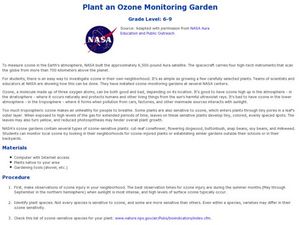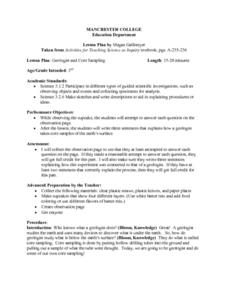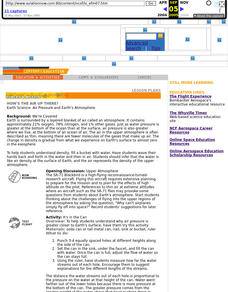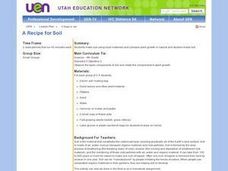Curated OER
Global Warming Quiz
In this global warming quiz worksheet, students compete a set of 12 multiple choice questions. Page contains a links to answers and additional activities.
Curated OER
Plant an Ozone Monitoring Garden
Students create a garden. In this ozone lesson, students discuss ozone injury, identify plants sensitive to ozone, and then plant their own ozone garden.
Science Matters
Slip Sliding Along
The San Andreas Fault is the largest earthquake-producing fault in California. In the seventh instructional activity in the 20 part series, pupils create maps of California, focusing on the San Andreas Fault system. The comparison...
Curated OER
Personal Written Response Activity
Pupils complete a final written project. In this personal response lesson, students respond in a creative way to one of the issues presented in the unit. Pupils may choose to create a series of postcards from a natural disaster,...
Curated OER
What's Happening to the Ozone?
Students identify causes of ozone depletion, generalize how that information affects everyday life, and discuss ways individuals can help slow down depletion of ozone.
Curated OER
Franklin Mountains
Fifth graders examine photographs of the eastern and western Franklin Mountains. As a class, they discuss what is shown and the different colored rocks and the orientation of the layers. In groups, they are given clay of two different...
Curated OER
Sedimentary Structures- An Adventure in Painting and Collage
Pupils identify and interpret concepts about how the Earth was formed and convey some of these ideas in a painting.
Students experiment with different types of paints and paint applicators to achieve a variety of visual textures....
Curated OER
Where to Live?
Students examine types of spatial data found in a GIS. In this geography lesson students use a GIS to facilitate analysis and decision making.
Curated OER
Aerology- The Study of Mars
Students investigate various aspects of the planet Mars. They examine a core sample that is simulated to make observations. Then compare the known sample with one that is unknown and differentiate between the two. Students hypothesize...
Curated OER
Excavating the Past
Students discover how palaeontologists conduct a dig for fossils and how they interpret the age of the fossils. In small groups, they prepare a "dig site" consisting of bones, rocks and soil layered in a cardboard box. They switch boxes...
Curated OER
Dig Magazine Archeology Quiz #60
For this Dig Magazine archeology quiz, students answer 4 multiple choice questions covering a variety of topics. Page contains answer and additional resources link.
Curated OER
Geologist and Core Sampling
Third graders observe a cupcake and attempt to answer each question on the observation page. They write three sentences that explains how a geologist takes core samples of the earth's surface. Students make sketches and write...
Curated OER
How's the Air Up There?
Young scholars experiment with soda cans and water to discover why air pressure is greater closer to Earth's surface.
Curated OER
Life in a Cup
Third graders make and maintain a mini terrarium. They keep a daily journal of what happens in their terrarium and record daily observations and measurements.
Curated OER
Recycled Water?
Students participate in a hands-on activity to investigate how water is recycled in a small environment, and determine how water is cycled on earth.
Curated OER
"Space" Investigations
Sixth graders understand the patterns of change observable on Earth as a result of the movement of the different bodies in the solar system. They identify the physical characteristics of the different components of the solar system.
Curated OER
A Recipe for Soil
Fourth graders use local materials such as leaves and other plant matter; sand and pebbles to make soil. They plant seeds in the manufactured soil and in natural soil and then observe and record the results.
Curated OER
Understanding Salinity
Students discuss why the ocean is salty. They discuss what salinity is. Students are told that is they want to know how much salt is in a body or water, they would use a special scientific tool. They complete an Estuarine Layers science...
Curated OER
Aquifers
Students participate in an experiment about aquifers. They answer questons and make observations about the experiment. They discuss how they can make a difference in the way water is used.
Curated OER
The Magic School Bus Out of this World
Pupils explore the craters that objects of different sizes and weights make. They use marbles, Ping-Pong balls, and aluminum-foil balls for this experiment. They investigate what would happen if they drop objects that aren't round.
Curated OER
Atoms, Kinetic Theory, Solids and Fluids
Students identify and describe the building blocks that make up an atom. They also compare the ages of atoms to the ages of the materials they compose,as well as, give examples that illustrate the small size of atoms.
Curated OER
Use Culinary Concoctions to Illustrate Geological Events
Incorporating food into your science lesson helps learners to visualize and taste the complex concepts of Geology.
Science Matters
A Model of Plate Faults
The San Andreas fault is one of the longest fault zones in the world. In a series of 20 lessons, the fourth lesson has pupils use a paper model to recreate various types of plate faults. Each is held in position then drawn...
Curated OER
A Model of the Sea-floor
Students create a paper model to illustrate sea-floor spreading.























